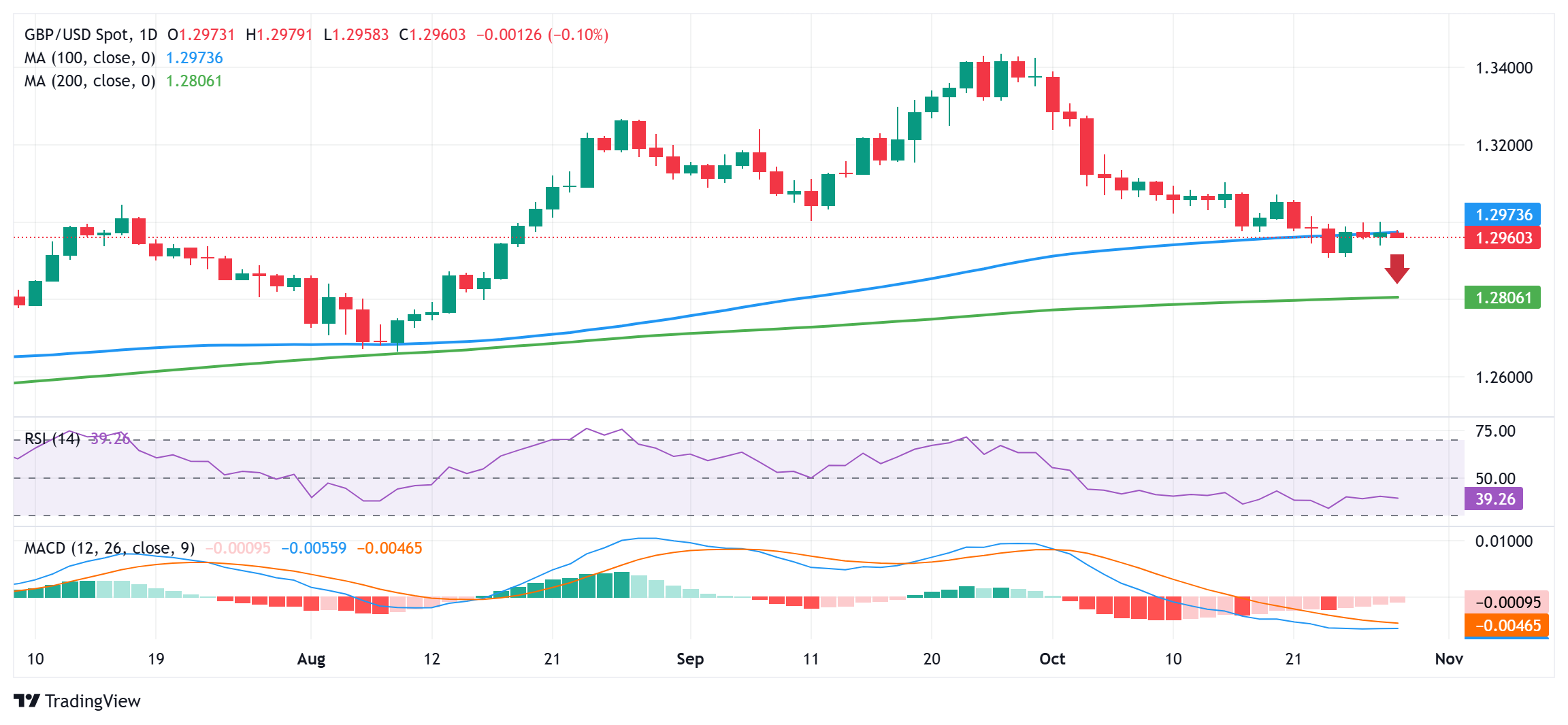- GBP/USD meets with a fresh supply on Tuesday and seems vulnerable to sliding further.
- Bets for smaller Fed rate cuts revive the USD demand and exert pressure on the pair.
- The technical setup favors bears and supports prospects for a further depreciating move.
The GBP/USD pair attracts fresh sellers following the previous day's good two-way price move and slides closer to mid-1.2900s during the Asian session on Tuesday. Spot prices, however, hold above the lowest level since August 16 touched last week and remain at the mercy of the US Dollar (USD) price dynamics.
Bets for a less aggressive policy easing by the Federal Reserve (Fed) assist the USD in stalling its overnight pullback from a three-month peak and drag the GBP/USD pair lower. Apart from this, rising bets for more interest rate cuts by the Bank of England (BoE) in November and December suggest that the path of least resistance for spot prices remains to the downside.
From a technical perspective, the recent repeated failures near the 1.3000 psychological mark and a breakdown below the 100-day Simple Moving Average (SMA) validate the near-term negative outlook. Moreover, oscillators on the daily chart are holding deep in negative territory and are still away from being in the oversold zone. Hence, a subsequent slide back towards the 1.2900 mark, or the monthly swing low, looks like a distinct possibility.
Some follow-through selling will be seen as a fresh trigger for bearish traders and pave the way for an extension of a downtrend from the 1.3435 region, or the highest level since February 2022 touched last month. The GBP/USD pair might then aim to test the very important 200-day SMA, currently pegged near the 1.2800 round-figure mark, with some intermediate support near the 1.2860 region.
On the flip side, the 1.3000 mark now seems to have emerged as an immediate strong barrier, above which spot prices could climb to the 1.3050 supply zone. A sustained strength beyond the latter might trigger a short-covering move and lift the GBP/USD pair beyond the 1.3100 round figure, towards the 1.3115-1.3120 resistance zone. Some follow-through buying will negate the negative outlook and shift the bias in favor of bulls.
GBP/USD daily chart
Pound Sterling FAQs
The Pound Sterling (GBP) is the oldest currency in the world (886 AD) and the official currency of the United Kingdom. It is the fourth most traded unit for foreign exchange (FX) in the world, accounting for 12% of all transactions, averaging $630 billion a day, according to 2022 data. Its key trading pairs are GBP/USD, also known as ‘Cable’, which accounts for 11% of FX, GBP/JPY, or the ‘Dragon’ as it is known by traders (3%), and EUR/GBP (2%). The Pound Sterling is issued by the Bank of England (BoE).
The single most important factor influencing the value of the Pound Sterling is monetary policy decided by the Bank of England. The BoE bases its decisions on whether it has achieved its primary goal of “price stability” – a steady inflation rate of around 2%. Its primary tool for achieving this is the adjustment of interest rates. When inflation is too high, the BoE will try to rein it in by raising interest rates, making it more expensive for people and businesses to access credit. This is generally positive for GBP, as higher interest rates make the UK a more attractive place for global investors to park their money. When inflation falls too low it is a sign economic growth is slowing. In this scenario, the BoE will consider lowering interest rates to cheapen credit so businesses will borrow more to invest in growth-generating projects.
Data releases gauge the health of the economy and can impact the value of the Pound Sterling. Indicators such as GDP, Manufacturing and Services PMIs, and employment can all influence the direction of the GBP. A strong economy is good for Sterling. Not only does it attract more foreign investment but it may encourage the BoE to put up interest rates, which will directly strengthen GBP. Otherwise, if economic data is weak, the Pound Sterling is likely to fall.
Another significant data release for the Pound Sterling is the Trade Balance. This indicator measures the difference between what a country earns from its exports and what it spends on imports over a given period. If a country produces highly sought-after exports, its currency will benefit purely from the extra demand created from foreign buyers seeking to purchase these goods. Therefore, a positive net Trade Balance strengthens a currency and vice versa for a negative balance.
Information on these pages contains forward-looking statements that involve risks and uncertainties. Markets and instruments profiled on this page are for informational purposes only and should not in any way come across as a recommendation to buy or sell in these assets. You should do your own thorough research before making any investment decisions. FXStreet does not in any way guarantee that this information is free from mistakes, errors, or material misstatements. It also does not guarantee that this information is of a timely nature. Investing in Open Markets involves a great deal of risk, including the loss of all or a portion of your investment, as well as emotional distress. All risks, losses and costs associated with investing, including total loss of principal, are your responsibility. The views and opinions expressed in this article are those of the authors and do not necessarily reflect the official policy or position of FXStreet nor its advertisers. The author will not be held responsible for information that is found at the end of links posted on this page.
If not otherwise explicitly mentioned in the body of the article, at the time of writing, the author has no position in any stock mentioned in this article and no business relationship with any company mentioned. The author has not received compensation for writing this article, other than from FXStreet.
FXStreet and the author do not provide personalized recommendations. The author makes no representations as to the accuracy, completeness, or suitability of this information. FXStreet and the author will not be liable for any errors, omissions or any losses, injuries or damages arising from this information and its display or use. Errors and omissions excepted.
The author and FXStreet are not registered investment advisors and nothing in this article is intended to be investment advice.
Recommended content
Editors’ Picks

AUD/USD turns south to near 0.6300 as US Dollar finds demand
AUD/USD fades its recovery and turn south again to test 0.6300 in the Asian session on Monday. US President Trump's impending tariffs and geopolitical tensions fuel fresh haven dmeand for the US Dollar while disappointing Chinese inflation data remains a drag on the Australian Dollar.

USD/JPY recovers above 147.50 on renewed US Dollar buying
USD/JPY is recovering losses above 147.50 early Monday. Fears over a global tariff war combined with US economic slowdown concerns fuel risk-off flows, fuelling a fresh US Dollar uptick while Japanese Yen buyers refuse to give up amid prospects of the Fed-BoJ policy divergence.

Gold struggles above $2,900 but bullish bias remains intact
Gold price is extending its range-play above $2,900 starting a new week on Monday, looking to defend the critical support line near $2,910. The US Dollar stays weak amid tariff war-led economic concerns and falling US Treasury yields.

Here's all that transpired in the White House Crypto Summit
In the White House Crypto Summit on Friday, President Donald Trump addressed several plans to foster a suitable regulatory environment for crypto in the US.

February CPI preview: The tariff winds start to blow
Consumer price inflation came out of the gate strong in 2025, but price growth looks to have cooled somewhat in February. We estimate headline CPI rose 0.25% and the core index advanced 0.27%. The moderation in the core index is likely to reflect some giveback in a handful of categories that soared in January.

The Best brokers to trade EUR/USD
SPONSORED Discover the top brokers for trading EUR/USD in 2025. Our list features brokers with competitive spreads, fast execution, and powerful platforms. Whether you're a beginner or an expert, find the right partner to navigate the dynamic Forex market.
